Singapore Rice Noodles: Noodles+Curry+Wok=Delicious
These noodles did not originate in Singapore.
Or, at least, that is what I am told. They are Cantonese in origin, possibly from Hong Kong, and they were first very popular in European Chinese restaurants. They made it to the US sometime in the 1980’s and spread through the Chinese-American restaurants to the point where they are now fairly standard menu items.
But, they probably didn’t come from Singapore, where admittedly, there are many Chinese of southern heritage, and where stir-fried rice noodles are a ubiquitous street food.
So, why are they called “Singapore Rice Noodles?” Well, as near as I can figure there are two reasons behind it. One, is because it sounds exotic, and anyone who has worked in a Chinese-American restaurant can tell you that exotic sounding names sell plates of food. Servers can tell you that, as can chefs and owners who make up these names–people just really like stuff that sounds like it came from a far-away, interesting place.
The second reason has to do with one of the primary seasoning ingredients: curry powder.
Curries are popular in Singapore, it being along the trade route between India and China, so the logic in naming the noodles probably had something to do with the use of curry powder in the dish. Even though the curries of Singapore use other ingredients besides curry powder in them–curry was apparently curry to the cook who named this rice vermicelli stir fry.
The truth is, I don’t really give a darned about why these delectable noodles are named after Singapore. The ironic thing about this dish is that while it wasn’t originally from Singapore, it was a Singaporan Chinese culinary arts student named NeeWee who got me addicted to eating it. NeeWee said himself that he knew they didn’t come from Singapore, but he didn’t really care–they tasted so good he was happy to claim them as authentic Singaporan cuisine. Besides, as he said, he was Chinese, and they were certainly Chinese, so they were part of his heritage anyway, so he might as well enjoy them every chance he got.
And enjoy them he, and then later, I, did. Once he got me to taste them, there was no going back. I crave the little saffron-colored strands of chewy-soft noodles which have lightly crisped on the edges like a horse craves clover. Sprinkled among the tangled nest of noodles like jewels in a jackdaw’s nest lay morsels of Cantonese roast pork, shreds of onion, scallion top, and sweet pepper, silvery bean sprouts and tiny curled pink shrimp. At our request, shreds of chili pepper would join these sweeter flavors, along with the hot chili oil with seed we would drizzle over the serving platter with abandon, bringing a fire to our tongues and a light to our eyes.
Neewee, myself and our friends had a lot of fun sharing platters of Singapore Rice Noodles; we’d go out to a favorite Chinese restaurant after class and gulp down platters of them, and guzzle pot after pot of tea while we laughed over the events of our day, talking culinary triumph and disaster, and arguing philosophy and food. It is because of Neewee that I eventually had to learn how to make these delicious noodles–here in Athens, there is no place I can go to get a decent plate of them otherwise.
I have, of course, made a few modifications, and I do so with no feelings of guilt or sense that I am violating a traditional recipe. For one thing, I have eaten Singapore Rice Noodles at enough restaurants to know that there is no singe standard recipe. The only constants seem to be rice vermicelli, curry powder, onion slices, red or green bell pepper slices, bean sprouts, and possibly shrimp. I have eaten menu versions which have had or lacked roast pork, chicken, scrambled egg, chile peppers, carrots, mushrooms, scallions and chile peppers. That is a pretty wide variation in ingredients–wide enough that to me, it means there is no one traditional recipe by which this dish is known, which can be held up as the standard of authenticity.
So, I feel no great angst over adding more vegetables to my version and using, instead of shrimp, and in addition to my own roast pork, Chinese lop cheong–sweet pork sausages. Zak doesn’t much care for stir fried shrimp, so I figured the sweet flavor of the air dried lop cheong would make a good substitute, as I find tiny shrimp to have a very sweet taste as well. (When I asked for the lop cheong at the local Asian market, I got teased by the owners for using Cantonese pronunciation instead of Mandarin. Ah, well. That is what I get for learning my Chinese by watching too many Hong Kong movies–Cantonese pronunciation.)
I also did experiment with one change which I suspect rendered the dish no longer Singapore Rice Noodles, but instead something along the lines of “Stir Fry Curry Noodles.” I used Guilin rice noodles–which look like rice spaghetti–instead of the traditional hair-fine rice vermicelli. These thicker noodles, pictured as they came out of the package here, made a very different dish–the noodles were not mushy, but were soupier, with a slippery texture–this is in large part because I added more liquid than was necessary to the wok to cook them. As the noodles cooled in our bowls while we ate them, they became more chewy and reminiscent of the proper texture of Singapore Rice Noodles, but they still were not what I considered right and proper.
It was tasty, but not properly what I would call Singapore Rice Noodles.
A word of warning, before we delve into the recipe. If you look at recipes for this dish in cookbooks and especially online, they usually counsel you to use way more liquid than is necessary to cook the noodles in the wok. The essence of this recipe is a balance between heat and liquid–too much heat and not enough liquid, and you will get oddly plastic-like too chewy noodles. Too little heat and too much liquid, and you will get slippery, soft and somewhat soupy noodles instead of properly chew-soft stir fried noodles.
It is a difficult balancing act to pull off, but in my recipe, I advocate the use of much less liquid than any other recipe I have found. However, when cooking with rice vermicelli, I have found that less is more–the amount of liquid I used was just enough to carry the curry powder flavor into the noodles and infuse them with the saffron color of turmeric. This softens the already soaked noodles just enough to soak up the flavors of the wok without making them slippery soft and overcooked.
The vegetables and meats you use are up to you. The ones listed are just the ones I happened to use this time around. If you are a vegetarian, substitute some pressed spiced tofu or some smoked tofu (or both) for the meats, and add some soaked Chinese black mushrooms to the mixture as well for their meaty texture and flavor. Use either vegetable broth or the soaking liquid from the mushrooms for the chicken broth. If you are a vegan, follow my suggestions for the vegetarians and just leave out the eggs.
However you make Singapore Rice Noodles, just remember to use rice vermicelli and plenty of good-tasting curry powder. The one I use is a combination of Penzey’s sweet curry powder and hot curry powder. (That mixture tastes really good in scrambled eggs and deviled eggs, too, though I never make curry with it at all.)
Please don’t be put of by the long ingredient list. That is mostly because I like lots of vegetables in my noodles. You don’t have to use so many as that. But if all the cutting doesn’t frighten you, try it my way, especially now when summer produce is at its height. I don’t think you will be sorry.
Ingredients:
12 ounces rice vermicelli
3-5 tablespoons peanut or canola oil
4 ounces lop cheong, cut on the diagonal into thin slices, then each slice cut into slivers
1/2 cup julienne slices purple onion
1/2 cup julienned carrot
1/2 cup julienned sweet bell pepper
1/4 cup thin green beans, cut on the diagonal the same size as the other vegetables
1/4 cup snow peas, stringed and cut on the diagonal in thin slices
4 ounces Chinese roast pork, cut into thin strips
2 eggs lightly beaten
3 tablespoons minced garlic
2 tablespoons minced fresh ginger
2-3 fresh hot chilies, sliced thinly on the diagonal (optional)
2 1/4 tablespoons Madras or other yellow colored curry powder
1 teaspoon raw or brown sugar
1/4 teaspoon salt
2 tablespoons thin or light soy sauce
1 tablespoon Shao Hsing wine
1/4 cup chicken broth, divided into two halves
1/2 cup bean sprouts, root ends picked off, rinsed and drained
1/4 cup thin diagonal slices scallion tops–dark green part only
1/2 cup cilantro leaves, rinsed and drained
1 teaspoon sesame oil
salt to taste
Method:
Soak the vermicelli in warm water to cover until they are thoroughly softened. This should take about a half hour to forty-five minutes. After they are thoroughly softened, drain them until they are needed in the stir fry.
Heat wok until it smokes; add two tablespoons oil and allow to heat for fifteen to thirty seconds.
Add lop cheong, and stir fry until it begins to curl and brown and renders its own fat. At that point, at the onion slices, and stir fry about one minute. Add carrots, stir fry another thirty seconds, then add the rest of the vegetables and stir fry for about a minute and a half. Add pork, stir fry another half minute or so, just to warm the pork.
Scrape contents of the wok into a clean bowl. Return wok to heat and if needed add another tablespoon of oil. Allow oil to heat for fifteen seconds, then add eggs, and stir fry until dry scrambled. Add this to the bowl of vegetables and meats.
Add another tablespoon of oil to wok. Allow to heat fifteen seconds, then add ginger, garlic and chilies, if you are using them. Stir fry until fragrant, about thirty seconds to a minute, then add sugar, salt and curry powder. Continue stir frying for another thirty seconds, then add the soy sauce, wine and 1/8 cup of the chicken broth.
Immediately add drained noodles, and stir and fry, working the liquid into the noodles. As the yellow color of the curry powder imbues the white noodles with flavor and tint, keep stirring. You will notice the noodles will shrink in volume slightly. At this point, you will see that the liquid that is not being absorbed by the noodles is being evaporated, and the noodles may begin to stick to the wok. If this happens, add the rest of the cooking oil, and keep stirring. What you want to see is the noodles begin to dry slightly, becoming a bit chewy. If they are too dry to your taste, add more chicken broth, a tablespoon at a time, from the reserved 1/8 cup of it. (I don’t usually need to do this, but you might. When I make these noodles, I always only use the 1/8 cup of chicken broth and no more–but your stove may be hotter.)
At this point, add the cooked meats, veggies and eggs to the wok and stir to combine. This takes good shoulder and forearm muscles–the noodles don’t like to be friendly at this point, and everything feels heavy. Keep working and you will prevail. Add the bean sprouts, scallions and cilantro, and the drizzle of sesame oil and take wok off heat. Stir these last bits int, and taste for salt, adding more as needed.
Serve steaming hot from the wok, but be aware that this is really good as cold leftovers from the fridge. I like them that way for breakfast or lunch, though I bet they would be good folded into an omelet, too.
17 Comments
RSS feed for comments on this post.
Sorry, the comment form is closed at this time.
Powered by WordPress. Graphics by Zak Kramer.
Design update by Daniel Trout.
Entries and comments feeds.

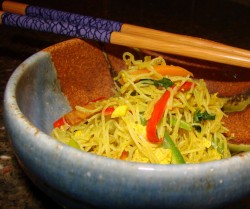
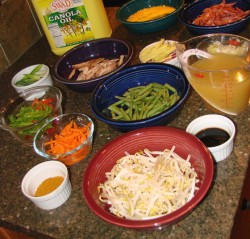
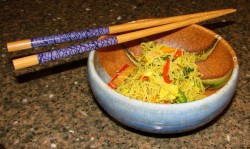
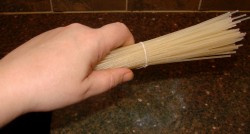
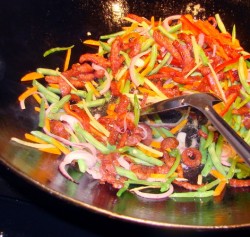
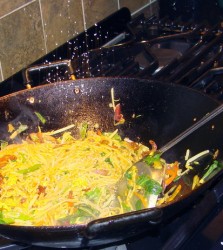


This looks so good. You’ve had my craving noodles for weeks. Dave has been cooking off your blog for me to appease me.
Comment by Danielle — August 30, 2007 #
I just read Singapore Sling instead of rice!
Actually either or both are most welcome. I have not been to Singpore for almost 18 months.
I miss you, Singapore
Comment by saju — August 30, 2007 #
Love Singapore Noodles!
btw Barbara, do you get people who see the list of ingredients in a Chinese dish and immediately get intimidated?
I’m trying to brainstorm ways to get people to try Chinese cooking – people who haven’t cooked much Chinese before – and the response I get sometimes is that the ingredients list is soooo long and unfamiliar.
I try to counter with “they are all “pantry” ingredients!
Comment by Steamy Kitchen — August 30, 2007 #
It’s funny you mention these. I had a good friend who was roomates with a Singaporean student in grad school, and she taught her how to make a version of this (only with fresh rice noodles) – and then my frind taught me. It was kind of a revelation to me, and for a few months in the late 1980’s I ate these every week.
Comment by Diane — August 30, 2007 #
Danielle–have Dave make these–they are awesome! You will love them, I promise. They are addictive, though–I have to warn you. My husband Zak never liked them overmuch in restaurants, but since I have been making them at home, he has gotten to where he craves them. Hee hee.
Saju–I hope to visit there someday myself. I am glad to remind you of a joyful place.
Jaden–I know what you mean about getting people into Chinese food. It can be hard–it is so intimidating for some folks. That is why I wrote my posts about Chinese pantry staples–giving people ten or a dozen or so items they need to cook basic Chinese foods. And then, I give recipes using those items. From the response I got, I think it helped.
Believe me–I know what you mean. I used to lead tours in really big Asian markets, and people were just bloody intimidated by all of the stuff they had never seen before–almost like sensory overload. Me–I am just the opposite. I see lots of stuff I don’t recognize, and I start picking it up, sniffing it, poking it and trying to figure out what it is and what to do with it.
But then, I think I am probably just exceptionally adventuresome that way. I’ll try anything at least two or three times.
Diane–I could eat them every week now.
I have limited access to fresh rice noodles, so I have never had them made that way. I wonder what they are like?
Comment by Barbara — August 31, 2007 #
Nope, not available at all in Singapore. Too bad really, my family used to eat them almost weekly in China Town when we lived in Canada. It was yummy and I kinda miss the dish.
Comment by mona — August 31, 2007 #
My mouth is watering! How can we solve my garlic problem!
Tessa
Comment by Tessa — September 1, 2007 #
I am drooling all over my keyboard – you are destroying my South Beach diet but what a way to go. Yum! I know that you are interested in China and Chinese food (duh) so you might enjoy this blog of two travelers in China – one of which (I believe) is Chinese-American – lots of great descriptions of food plus China off the beaten track.
http://eatdrinknbmerry.blogspot.com/2007/08/yangshuo-china-guangxi-province-hello.htmlLot
Comment by Nancy — September 1, 2007 #
Eat, Drink, Be Merry Correct URL:
http://eatdrinknbmerry.blogspot.com/
Comment by Nancy — September 1, 2007 #
Made these on Sunday after a trip to the Asian market to stock up on a few things we’d run out of. They had roast pork already prepared, in convenient little to-go packages. There wasn’t time to make the pork at home, so that allowed me to follow the recipe almost exactly.
I didn’t have bean sprouts (forgot!) but some peeled, seeded and julienned cucumber is my standard substitute and worked well.
Singapore Noodles in restaurants have not impressed but these were mighty tasty. Wife and daughter liked them, too. Thanks for the recipe!
Comment by Adam Ziegler — September 3, 2007 #
Mona, try your hand at making them at home–they will likely be even better than what you get out.
Tessa–I can leave garlic out of your portion, but be aware that it is in many versions in Chinese restaurants. (Not to mention that they use much more oil than I do, too.)
Thanks for the link, Nancy!
Adam–made at home is always better. I couldn’t sneak the cucumbers in mine, though, because Zak and Morganna both dislike cukes intensely.
I am glad you liked the recipe!
Comment by Barbara — September 4, 2007 #
In Malaysia, the Singapore fried noodles are actually made with ketchup and chili sauce, instead of curry powder…so it tasted sweet and sour instead or spicy. Go figure…now I am not even sure what is the real Singapore noodles. 😛
Comment by Rasa Malaysia — September 21, 2007 #
Yeah, you can’t get this in Singapore. Instead, we have Char Kway Teow, hokkien Mee, mee Goreng, and Mee rebus. All very good singaporean noodle dishes. I’m in the states right now and I like getting “Singapore” noodles, mainly just because its spicy………still not as good as hawker fare but better than the other crappy fake Asian dishes in the states! lol
Comment by Singaporekid — November 2, 2007 #
Hello, Are you my old friend Barbara , (mother of Ricky and Lia)???? Trying to track you down. I will have a short layover in Singapore soon. Let me know if I have hit on to you, this blog seems to fit your bill. Kathy (mother of Bryce and Lauren)
Comment by Kathy Gammon — April 6, 2008 #
Kathy–you have the wrong Barbara, but it is nice to meet you anyway!
Comment by Barbara — April 6, 2008 #
Hey Barbara, bet you havent had a note yet on a singaporean recipe from the bottom bit of the African continent!
Thanks for this recipe, had a craving for this on a sultry Sunday evening having had many variations of the dish from Hongkong to Malaysia, (mostly hawkers) and am following your basics here – with variation as becomes the dish.
Regards from South Africa, and a hot wok.
Matt
Comment by jomat — October 12, 2008 #
I was searching for this recipe-this sounds great! We just got back from Vegas and I had this at the Chinese restaurant at the MGM Grand-it was simply awesome! The flavours were simply fantabulous-let me see if I can make a similar dish 🙂
Don’t worry-will let you know how it turns out!!
Comment by Sweta — July 13, 2009 #